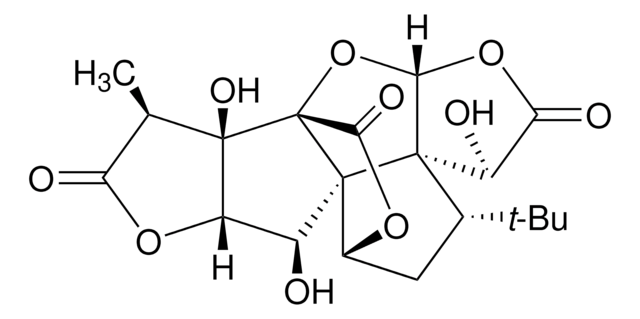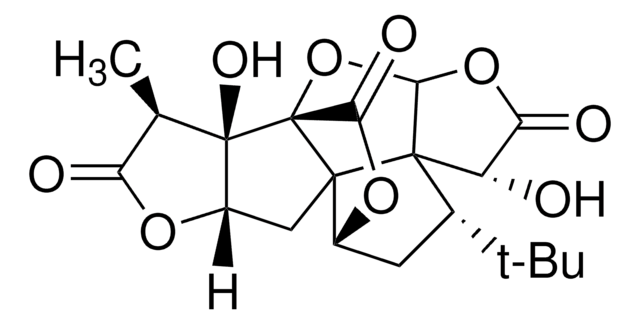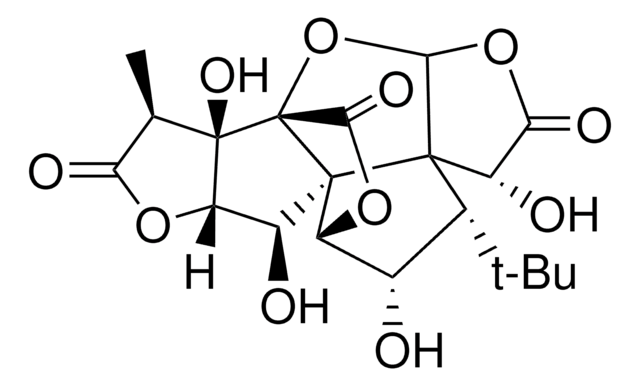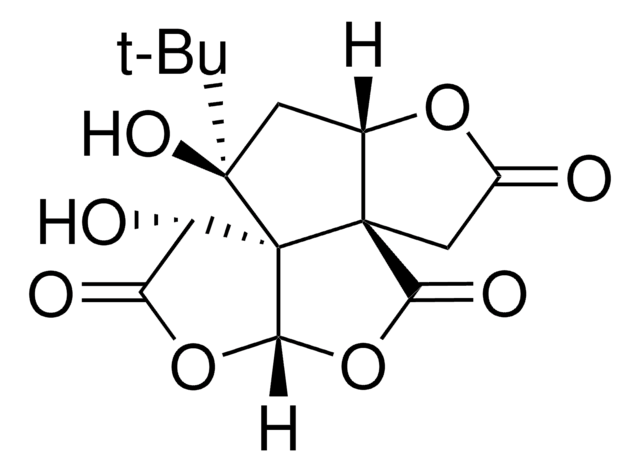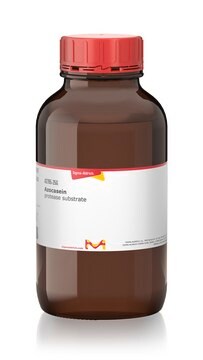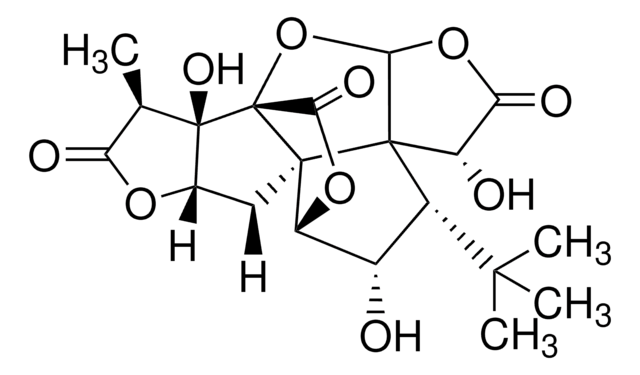B9031
(−)-Bilobalide from Ginkgo biloba leaves
≥93% (HPLC)
Sinônimo(s):
Bilobalide
Faça loginpara ver os preços organizacionais e de contrato
About This Item
Fórmula empírica (Notação de Hill):
C15H18O8
Número CAS:
Peso molecular:
326.30
Número MDL:
Código UNSPSC:
85151701
ID de substância PubChem:
NACRES:
NA.28
Produtos recomendados
fonte biológica
plant leaves (Ginkgo biloba)
Ensaio
≥93% (HPLC)
Formulário
powder
técnica(s)
HPLC: suitable
cor
white
temperatura de armazenamento
−20°C
cadeia de caracteres SMILES
CC(C)(C)[C@]1(O)CC2OC(=O)C[C@@]23C(=O)OC4OC(=O)[C@H](O)[C@]134
InChI
1S/C15H18O8/c1-12(2,3)14(20)4-6-13(5-7(16)21-6)10(19)23-11-15(13,14)8(17)9(18)22-11/h6,8,11,17,20H,4-5H2,1-3H3/t6-,8-,11-,13-,14+,15+/m0/s1
chave InChI
MOLPUWBMSBJXER-YDGSQGCISA-N
Descrição geral
Bilobalide is a biologically active terpenic trilactone (terpenoid) extracted from Ginkgo biloba. It is synthesized from geranylgeranyl pyrophosphate (GGPP).
Aplicação
(-)-Bilobalide from Ginkgo biloba leaves has been used as a reference substance to study the antimicrobial activity of different fractions of G.biloba leaves against a number of Gram-positive and negative bacteria and yeasts.
Ações bioquímicas/fisiológicas
Bilobalide is an inducer of cytochrome P450 enzymes CYP3A1 and CYP1A2. It exhibits neuroprotective, anti-inflammatory, anti-oxidative and anti-apoptotic properties. Bilobalide, a γ-aminobutyric acid (GABA) AA-rho, 5-hydroxytryptamine type 3 (5-HT(3)) receptor antagonist, may be used to study the function of these receptors in the brain processes such as cognition and memory. It serves as a specific platelet-activating factor receptor antagonist, which helps in the treatment of cardiovascular (Alzheimer′s disease) and cerebrovascular diseases.
Bioactive terpenoid found in Ginkgo biloba.
Código de classe de armazenamento
11 - Combustible Solids
Classe de risco de água (WGK)
WGK 3
Ponto de fulgor (°F)
Not applicable
Ponto de fulgor (°C)
Not applicable
Equipamento de proteção individual
Eyeshields, Gloves, type N95 (US)
Escolha uma das versões mais recentes:
Já possui este produto?
Encontre a documentação dos produtos que você adquiriu recentemente na biblioteca de documentos.
Os clientes também visualizaram
Induction of cytochrome P450 3A by the Ginkgo biloba extract and bilobalides in human and rat primary hepatocytes
Zhou SF, et al.
Drug Metabolism Letters, 2(1), 60-66 (2008)
Antimicrobial investigation of semipurified fractions of Ginkgo biloba leaves
Mazzanti G, et al.
Journal of Ethnopharmacology, 71(1-2), 83-88 (2000)
Protective and therapeutic role of Bilobalide in cuprizone-induced demyelination
Sui RX, et al.
International Immunopharmacology, 66, 69-81 (2019)
Molecular cloning, characterization, and functional analysis of acetyl-CoA C-acetyltransferase and mevalonate kinase genes involved in terpene trilactone biosynthesis from Ginkgo biloba
Chen Q, et al.
Molecules (Basel), 22(1), 74-74 (2017)
Flaubert Tchantchou et al.
Journal of Alzheimer's disease : JAD, 18(4), 787-798 (2009-08-08)
Loss of synapses has been correlated with dementia in Alzheimer's disease (AD) as an early event during the disease progression. Hence, synaptogenesis and neurogenesis in adulthood could serve as a therapeutic target for the prevention and treatment of AD. Recently
Nossa equipe de cientistas tem experiência em todas as áreas de pesquisa, incluindo Life Sciences, ciência de materiais, síntese química, cromatografia, química analítica e muitas outras.
Entre em contato com a assistência técnica